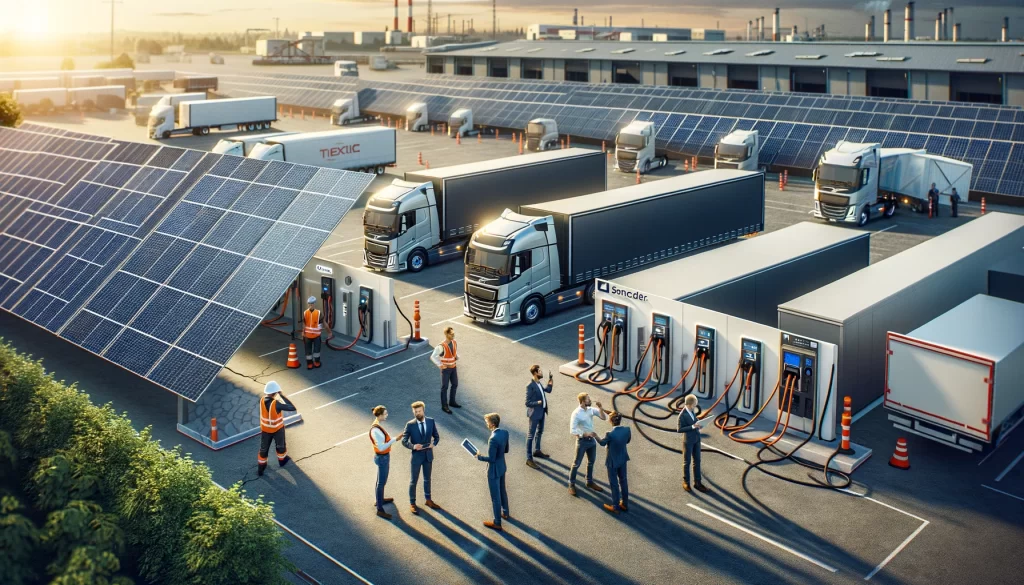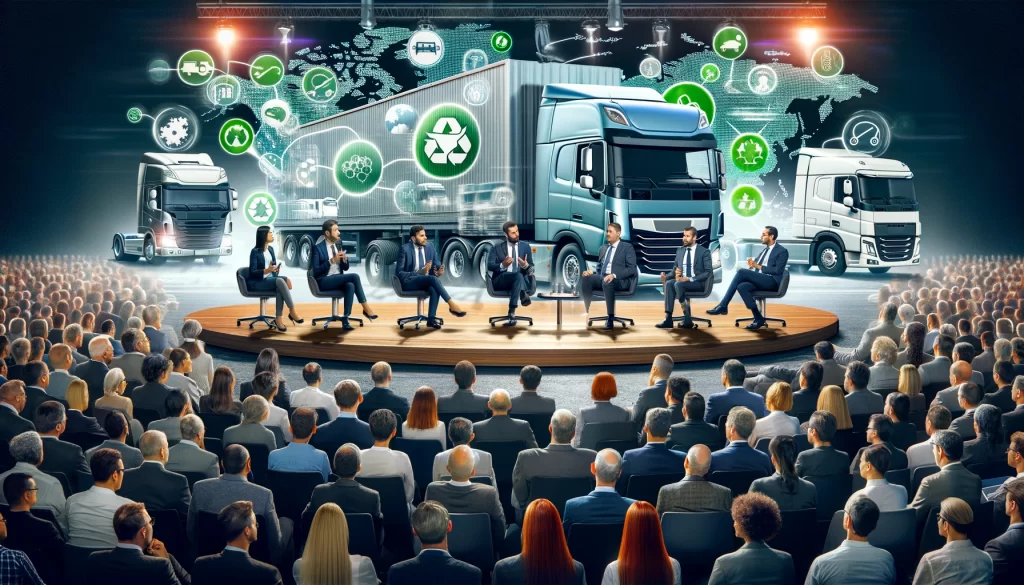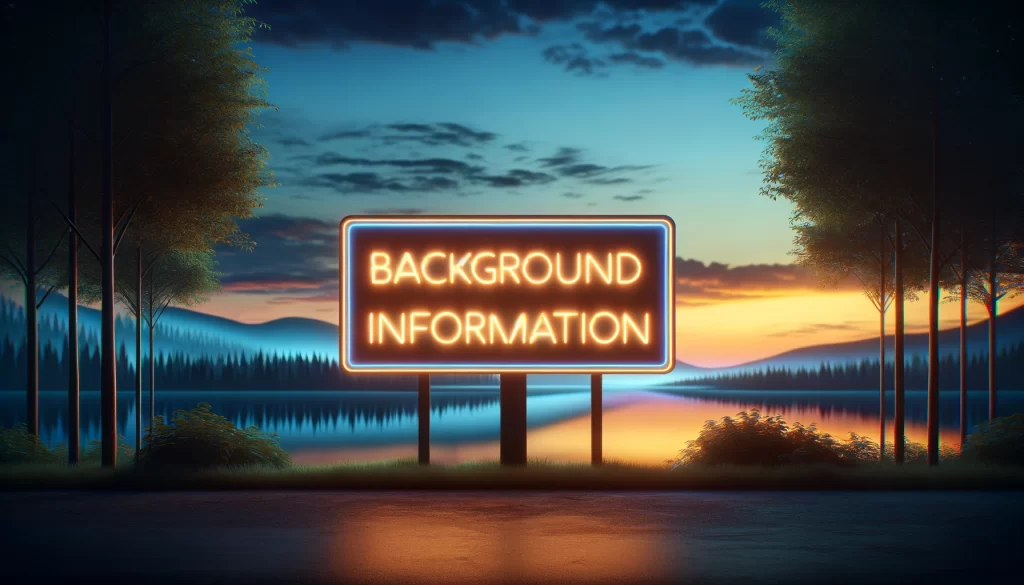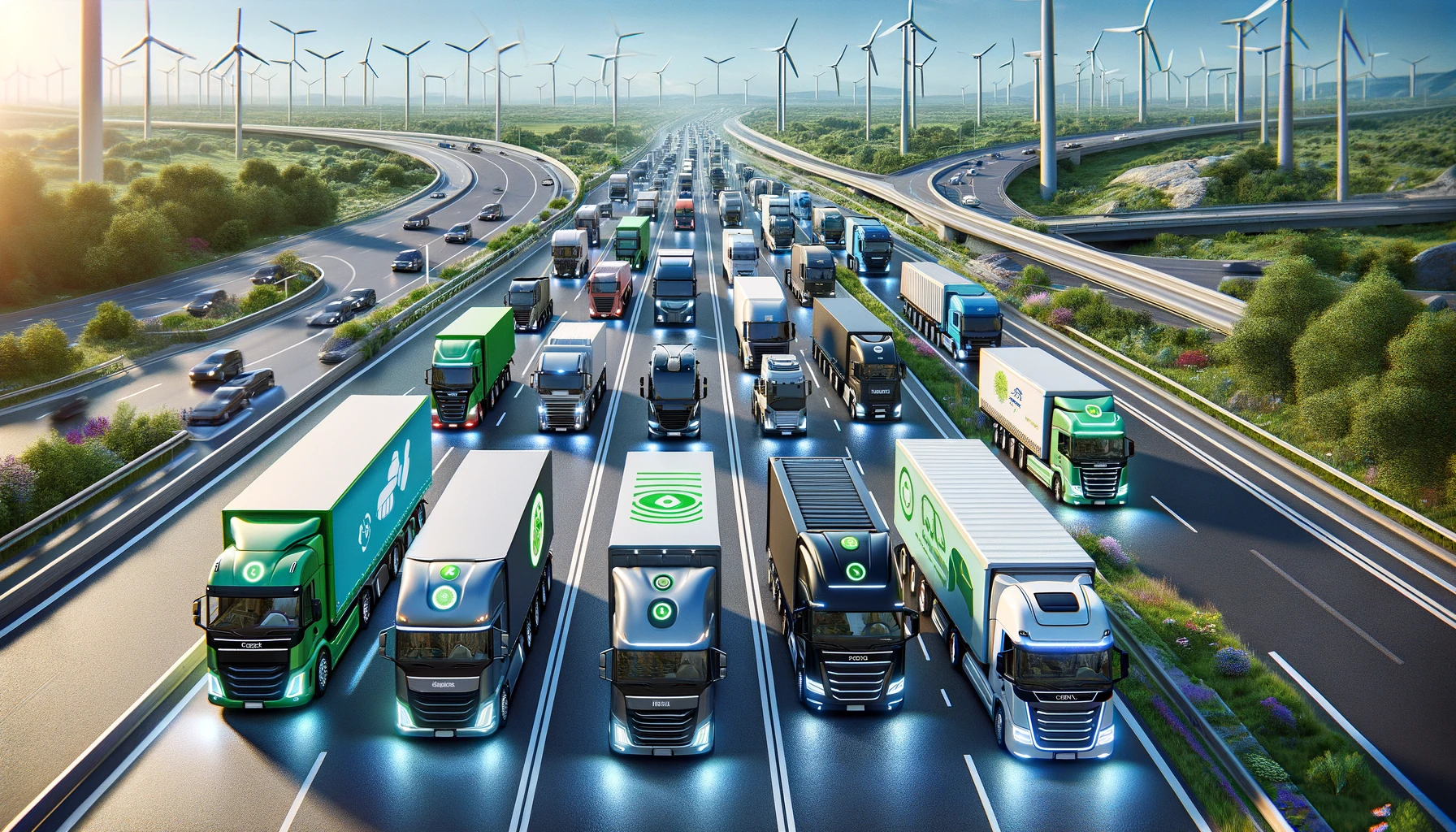In a landmark decision by the Biden administration, the United States has set the most rigorous standards yet for reducing pollution from heavy-duty trucks. This groundbreaking move has sparked a wave of support from public health and environmental groups. They view it as a significant victory for the future of zero-emission vehicles—trucks that don’t rely on fossil fuels and, as a result, do not emit harmful pollutants. However, this decision has also drawn criticism from some quarters of the trucking industry, who argue that the transition to electric vehicles (EVs) is currently impractical due to limitations in the necessary infrastructure, such as charging stations.
The scope of these new regulations is broad, encompassing a variety of large vehicles, including city buses, delivery trucks, garbage trucks, and the massive 18-wheelers that traverse our highways. The responsibility to comply with these rules falls on the manufacturers of these vehicles. Although they have some freedom in how they meet these standards, it is anticipated that many will turn to battery-powered technology as their solution.
These standards are part of a broader set of rules issued by the Environmental Protection Agency (EPA), aimed at reducing not just the carbon emissions contributing to climate change, but also other pollutants like soot and smog that have direct negative impacts on human health. Paul Billings from the American Lung Association expressed his gratitude for these measures, remarking, “On behalf of everyone who breathes, thank you.”
EPA Administrator Michael Regan emphasized that these robust vehicle standards are a critical response to the climate crisis, underlining the urgency of addressing global warming. The anticipated benefits of these rules are substantial, with an estimated value of $13 billion annually. This figure includes the health benefits from cleaner air, the positive impact on climate, and the financial savings for truck operators due to lower fuel and maintenance costs.
Despite the promise of long-term savings and environmental benefits, the oil industry and some within the trucking sector have expressed their intentions to challenge these new regulations in court. Heavy-duty trucks, although only making up about 5% of the U.S. vehicle fleet, are responsible for a significant 20% of transportation-related emissions, highlighting the importance of these new standards.
The EPA introduced these rules after a period of public and industry consultation. Modifications were made to the initial proposal to implement the rules more gradually over the coming years, with the most stringent requirements set to take effect in the early 2030s.
The transition to zero-emission heavy-duty trucks is acknowledged as a challenge, particularly due to the higher initial costs compared to traditional diesel vehicles. However, the EPA maintains that the long-term benefits, including reduced operational costs, justify the transition. This viewpoint, however, is not unanimously shared within the trucking industry, with some voicing concerns over the feasibility and cost-effectiveness of these changes.
Jed Mandel, representing the Truck and Engine Manufacturers Association, described the new rules as potentially “the most challenging, costly and potentially disruptive … in history,” while also stressing that there remains a commitment within the industry to achieve a zero-emission future for trucking.
The American Bus Association expressed support for climate initiatives but criticized the EPA’s approach as overly aggressive, potentially doubling costs for the motorcoach industry. Todd Spencer of the Owner-Operator Independent Drivers Association accused the administration of prioritizing environmentalist agendas over the practical concerns of small-business truckers, vital to the national economy.
Countering these criticisms, Laura Kate Bender from the American Lung Association dismissed the industry’s cost complaints as exaggerated, underscoring the longstanding tendency of polluting industries to resist environmental regulations.

The Case of Light-Duty Vehicles
Cars, SUVs, vans, and most pickup trucks, which are lighter and easier to manage compared to their heavy-duty counterparts, have recently received their own set of environmental regulations from the EPA. These rules, which were heavily discussed and adjusted to address the concerns of car manufacturers, are still quite strict. By the year 2032, it’s expected that over half of all new cars and smaller vehicles will be fully electric, with this figure rising to two-thirds when including plug-in hybrids.
The move towards electric vehicles (EVs) is more pronounced in the case of these lighter vehicles because they’re simpler to convert to electric power. They don’t need as large batteries due to their lighter weight, making them easier and quicker to charge. Comparatively, charging a large truck requires a significant amount of energy. To illustrate, Matt Horton, the CEO of Voltera, a company that develops EV charging stations, mentioned that a single charging station for a fleet of big trucks could use as much electricity as a huge building like the Empire State Building. However, he believes the technology to support this already exists, and the EPA’s rules offer businesses a clearer future, encouraging investment in this area.
Besides the need for charging stations, the electric grid itself must be upgraded to handle the increased demand for electricity. This is part of the broader challenge of transitioning to electric vehicles across all types, not just the light ones.
The Case of Heavy-Duty Vehicles
Not all heavy-duty vehicles face the same hurdles when it comes to reducing emissions. Consider the differences among a school bus that stays parked for most of the day, a garbage truck that follows a daily route within a city, and a long-haul tractor-trailer that travels hundreds of miles nonstop. Each type of vehicle has unique needs and challenges in moving away from fossil fuels.
Battery-powered vehicles are already suitable for jobs with shorter, predictable routes, like school buses and garbage trucks, because these can easily return to a central location to recharge. The government is even helping fund electric school buses, which is great for both the environment and the health of school children by reducing their exposure to harmful diesel fumes.
Long-haul trucking, however, poses a more significant challenge. The main alternatives here are battery-powered trucks and those that run on hydrogen. Hydrogen trucks can be refueled quickly but are not yet cost-effective and would require an entirely new support infrastructure. Battery trucks, on the other hand, carry the drawback of added weight from the batteries, which cuts down on the cargo they can carry, not to mention the difficulty in finding places to recharge during long trips.
The EPA has considered these varied challenges in its regulations, predicting that zero-emission trucks with sleeping cabs for long-haul trips won’t become a significant part of the market until around 2030. Trucks used for shorter routes are expected to adopt zero-emission technology more quickly.
Some Welcome Them While Others Remain Skeptical
Whether these new environmental rules for trucks are realistic has sparked a lot of debate among manufacturers, drivers, and some people who run truck fleets. But health organizations, like the American Lung Association, are all in on these standards. They believe these rules could save lives.
Dr. Franziska Rosser, speaking for the American Thoracic Society, highlighted how these rules could make the air cleaner in the short term. This means kids might have fewer asthma attacks. And in the long run, it could help slow down climate change, which is good news for everyone, especially the kids she looks after.

Groups that focus on protecting the environment, like the Environmental Defense Fund, are cheering these rules on. They think the rules are not only good for the climate but also totally doable.
Craig Segall from Evergreen Action, a group that works on climate issues, thinks these rules are a critical step in reducing pollution from transportation. He mentioned that recent federal money for building places to charge electric trucks will make it easier for the trucking world to meet these ambitious goals.
On the flip side, industries like oil and biofuels aren’t fans. They argue that these rules might not work out as planned and could make it harder for businesses to secure enough energy for their operations and keep costs down, if we move away from traditional engines too fast.
The American Petroleum Institute and the American Fuel & Petrochemical Manufacturers, two big names in these industries, have even talked about taking this to court or asking Congress to step in.
The trucking industry itself has mixed feelings.
Jacqueline Gelb from the American Trucking Associations pointed out that they’re not happy with the rules as they are now but are willing to keep talking with the EPA. Even though the EPA made some changes to ease into the new rules, there’s still worry about how this might affect their finances.
Others in the industry are more direct. Monte Wiederhold, a truck fleet owner, has openly doubted whether electric trucks are a practical choice and thinks they might not ever be.
There’s concern that these rules might make truck drivers stick with their older, diesel trucks longer, which could mean missing out on the health benefits of newer, cleaner trucks.
However, some big companies that use a lot of trucks, like Amazon and DHL, are on board with going electric as part of their plans to tackle climate change. They were even among those pushing for tougher rules.
Then there are the truck manufacturers, the ones who actually have to follow these new rules. They’re putting a lot of money into developing electric trucks and have set goals for selling these cleaner vehicles. Some, including Ford, have even called for stronger rules to help speed up the move to electric vehicles.
But there’s a big “but” here—they’re worried about whether there will be enough places to charge these electric trucks. Jed Mandel has warned that without enough charging stations, selling electric trucks could be very difficult. It’s like having a great product that no one can use because the necessary support isn’t there. According to him, “That is a recipe for disaster.”
This article is based on the following article:

Background Information
Understanding these key concepts and the positions of different stakeholders helps clarify the challenges and opportunities presented by the transition to zero-emission vehicles, the importance of government regulations in driving change, and the various impacts on industry, public health, and the environment.
Greenhouse Gas Emissions and Climate Change
- Greenhouse gases (GHGs): These are gases that trap heat in the atmosphere, contributing to the greenhouse effect and global warming. Carbon dioxide (CO2), methane (CH4), and nitrous oxide (N2O) are primary examples.
- Climate change: Refers to significant changes in global temperatures and weather patterns over time. While climate change is a natural phenomenon, scientific research shows that human activities have been a major factor since the 1800s, primarily due to GHG emissions from burning fossil fuels.
Heavy-Duty vs. Light-Duty Vehicles
- Heavy-duty vehicles include large trucks and buses designed for transporting goods and people, known for consuming more fuel and producing more emissions per mile compared to personal cars.
- Light-duty vehicles are passenger cars, including sedans, SUVs, and small trucks. These vehicles are generally more fuel-efficient and emit less pollution per mile than heavy-duty vehicles.
Zero-Emission Vehicles (ZEVs)
- ZEVs are vehicles that emit no exhaust gas from the onboard source of power. This category includes battery-electric vehicles (BEVs), which run on electric power stored in batteries, and hydrogen fuel cell vehicles (FCVs), which produce electricity through a chemical reaction between hydrogen and oxygen.
The Role of the Environmental Protection Agency (EPA)
- The EPA is a federal agency tasked with protecting human health and the environment by creating and enforcing regulations based on laws passed by Congress. The EPA’s new regulations on vehicle emissions aim to reduce GHG emissions, improve air quality, and encourage the transition to cleaner energy sources.
Infrastructure for Electric Vehicles
- Charging stations: Electric vehicles require charging infrastructure, similar to gas stations but for electric charging. The availability and convenience of charging stations are critical for the widespread adoption of EVs.
- Electric grid: The network that delivers electricity from producers to consumers. Expanding the use of electric vehicles increases the demand for electricity, which requires improvements and expansions to the electric grid.
Industry Perspectives
- Manufacturers: Vehicle makers are investing in electric vehicle technology but are concerned about the availability of charging infrastructure and the market readiness for a rapid transition to ZEVs.
- Trucking industry: Some in the trucking industry are concerned about the feasibility and costs of transitioning to electric trucks, especially given the current state of the infrastructure and the higher upfront costs of electric vehicles.
- Environmental and health advocates: Groups like the American Lung Association support stricter emissions standards because of the benefits to air quality and public health, particularly for conditions like asthma which can be exacerbated by air pollution.

Debate/Essay Questions
- Should the government mandate the adoption of zero-emission vehicles, or should the market dictate the pace of transition?
- How can the transition to zero-emission heavy-duty trucks be made more equitable for small businesses and independent operators?
- How should the clash between environmental advocacy groups and the oil and biofuels industries over vehicle emissions regulations be resolved?
Please subscribe to Insight Fortnight, our biweekly newsletter!
